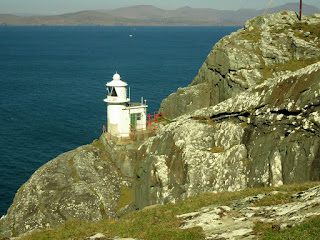We drove from the town of Bantry down the peninsula on the north side and then crossed over the Seefin ridge to the south side to drive to the very end of Sheep’s Head. The roads are very narrow and twisty, so it makes for slow going. As it was a fine day, quite a few people were driving around and more people than we expected were at the tip of Sheep’s Head.
The view from the parking area is quite banal, so there is a 2km trail to the tip of Sheep’s Head, where there is a lighthouse. We took the well-made path expecting to find a typical coastal lighthouse, only to come upon a mini lighthouse, it was hilarious.
Rather than walking back up the 2 km path to the parking area, we followed a path through some boggy ground, that then climbed up the hills from the tip of Sheep’s Head. This was a pretty good walk and was about 5 km in total.
View from the end of Sheep's Head Peninsula
Mini Lighthouse near the tip of Sheep's Head Peninsula
As we got close to the parking area a sheep and her two lambs were right beside the trail. The mother started to bleat for the lambs to get in gear and follow her. They both got a bit bogged down in the tall grass and heather and made some pseudo bleating sounds, but then got their footing. Since they were right beside us, but were on the verge of bolting off, we talked to them so that they stopped to stare and then we got a few good photos.
Sheep on Sheep's Head Peninsula
I had planned on going to Mizen Head, which is the extreme southwest point of Ireland, but we were fed up with slow roads by this time, so we went to Skibbereen to get some cheese and meat, then we had a cappuccino and drove back to Kenmare.
There are a lot of dairy cattle in Co. Cork, and it seems to be the dairy region of Ireland, as we have noticed that the majority of cheese we purchase comes out of Co. Cork. All of the towns in the area are also very pretty, as well as rather tourist oriented.
We tried a Powers whiskey in the pub tonight, as the old guy we talked to in Achill drinks Powers and suggested we try it. It is a lot better than Jameson, and more like a Scottish whisky.
The History of Ireland continues...
The Beginning of the ‘Troubles’
The Troubles is a term that is applied to the thirty-year period of sectarian violence in Northern Ireland. In the mid 1960s, Reverend Ian Paisley, the founder of the Free Presbyterian Church, was on high alert for any politician who would betray Ulster, Unionism and Protestantism, by giving anything to the Catholics. In 1968, Paisley forced the local constabulary to remove a flag of the Republic of Ireland, from a window in the Catholic sector of Belfast, rioting ensued for a period of four days.
Paisley drew support from working class Protestants whose jobs in heavy industry were falling away; they were angry with Union leaders and feared change. At the same time, the Catholics were beginning to gain a level of assertiveness as they pursued secondary education and took up professional careers, although not in government, as those positions were for the Protestants. The Catholics were not focussed on republicanism, rather, they were fed-up with blatant discrimination and the fact that they held few civic government council seats, even in Derry, which was predominately Catholic.
The Protestants viewed the civil rights complaints of the Catholics as just another strategy to end partition. The Ulster Volunteer Force (UVF) re-formed in 1966, and some of their members fatally shot a young Catholic in Belfast, the killers were sentenced to life in prison and the UVF was banned. This event was important, as it demonstrated that the Unionists would resort to violence.
The Catholics began to organize protest marches; when they marched in Derry, the constabulary went out of control and attacked the protesters, this was captured on film and broadcast to a shocked and outraged audience in the Republic of Ireland.
A group of students in a university in Belfast, calling themselves the People’s Democracy (PD) organized a protest walk in early 1969, from Belfast to Derry. The walk started out with a small group, but gathered supporters along the way, including republicans. The protesters were harassed by both Unionists and the constabulary. Near Derry, the marchers were attacked and beaten by Protestants, which were organized by an associate of Paisley.
In August, the Royal Ulster Constabulary (RUC) wanted to enter a Catholic area of Derry, known as the Bogside. The Catholics attempted to fend them off and the ensuring battle was filmed and broadcast to the world; the British army had to come in and put an end to the ‘Battle of the Bogside.’ Throughout 1969, rioting and killing ensued, to the point where the RUC used machine guns for crowd control in Belfast. The British army had to come in and restore order; interestingly, British police forces refused to go to Northern Ireland to relieve the RUC.
The fact that modest reforms, such as ‘one man one vote’ exploded into such violence, demonstrated that the Protestants could not embrace any change, reform or inclusion of Catholics. Northern Ireland was to protect and to promote the interests of the Protestants. This ideology, along with the political structure of Protestant interests first, was the path to collapse.




No comments:
Post a Comment